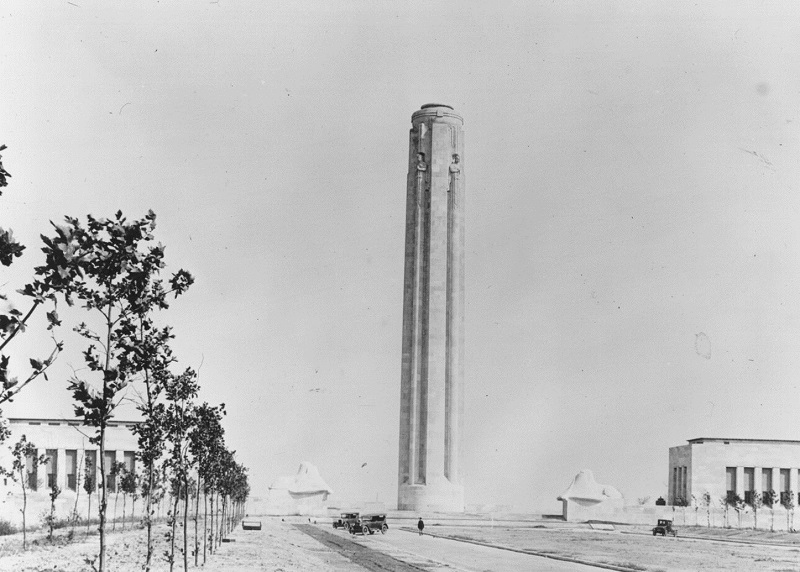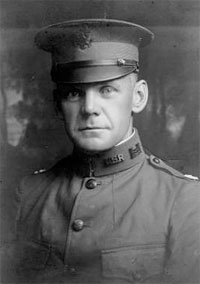On February 9, 1920, the City Council approved ambitious plans for the construction of Liberty Memorial south of Union Station. The Liberty Memorial Association, which initially consisted of 40 prominent citizens, envisioned a monument that would be among the world’s most spectacular memorials to World War I veterans.
A patriotic fervor characterized Kansas City shortly after the Armistice on November 11, 1918. The war had claimed the lives of 441 Kansas Citians, and seemingly everyone wanted a memorial for their sacrifices. The City Council appointed the Liberty Memorial Association, led by lumber tycoon Robert Anderson Long, to investigate possible design, locations, and funding.
The largest question was whether the memorial would be a dedicated structure or a functional municipal building such as a stadium or art center. Unlike many cities or universities that chose to construct utilitarian buildings with the moniker “Memorial” as a name, the Liberty Memorial Association settled on a monument dedicated solely to the commemoration of the war. A single-purpose memorial could remain valued for perhaps centuries to come, whereas visitors to a civic building might eventually forget its memorial aspects.
By November 1919, the Liberty Memorial fund drive had raised $2,517,000 from 83,000 contributors. Overall more than a quarter of Kansas City’s total population contributed at an average amount of $24.10; the equivalent of $288.84 in 2008 dollars according to the Consumer Price Index compiled by the U.S. Bureau of Labor Statistics. With the money raised, the council formally approved the project on February 9, 1920.
The council shortly decided on the area south of Union Station because the memorial would be one of the first sights visitors would see. At the time, this plot of land was known as “Signboard Hill” because of its unsightly buildings and advertisements.
A design contest resulted in the selection of a plan drawn by Harold Van Buren Magonigle, an architect from New York. Finally, on November 1, 1921, the city held a site dedication ceremony for the beginning of construction undertaken by the Wight and Wight architectural firm.
Over 100,000 people attended the ceremony held during the American Legion’s third national convention. The distinguished speakers that day included the Allied countries’ chief military leaders, who had never assembled in one place at the same time. They were Lieutenant General Baron Jacques, from Belgium; General Armando Diaz, from Italy; Marshal Ferdinand Foch, from France; Admiral David Beatty, from Great Britain; and General John J. Pershing, from the United States.
The Liberty Memorial structure was finally completed in 1926 with certain landscaping and design elements to be added over the next decade. A second dedication ceremony drew an even larger crowd than the first as President Calvin Coolidge and Marie, Queen of Romania, gave keynote speeches.
Liberty Memorial underwent further improvements through the 1930s and became a particularly popular destination for members of the military during the 1940s. The 1950s, however, brought neglect as Kansas City, Missouri, cut the maintenance budget for the monument to reduce spending.
The structure was cleaned in 1961, but underlying structural defects went untouched. As a result, Liberty Memorial closed to visitors due to hazardous conditions in 1994. The longstanding neglect is commonly explained as a result of the Second World War overshadowing the First World War in the nation’s memory.
Despite decades of disregarding maintenance on the monument, Kansas City dedicated resources to restore Liberty Memorial. From private donations, increased taxes, and funding from the state of Missouri, the city raised $45.5 million between 1997 and 2000. The monument finally reopened in May 2002, after two years of reconstruction.
Today, Liberty Memorial remains the only museum in the United States that is dedicated to World War I alone. Its 217 foot tower, topped by a giant flame, rests on an imposing base structure that includes water fountains, statues, and stately landscaping. The National World War I Museum at Liberty Memorial, which Congress designated as the nation’s official World War I museum, opened in December 2006. It displays an unparalleled collection of artifacts pertaining to the First World War. In addition, the museum’s Research Center hosts thousands of archival and secondary materials available to anyone interested in researching the conflict.
Read biographical sketches of people involved in the Liberty Memorial Association and profiles of buildings prepared by the Missouri Valley Special Collections, The Kansas City Public Library.
- Biography of George E. Kessler (1862-1923), Landscape Architect; designed the landscaping at Liberty Memorial, by Susan Jezak Ford, 2003
- Biography of Robert A. Long (1850-1934), Lumberman; first president of the Liberty Memorial Association, by Daniel Coleman, 2008
- Biography of J. C. Nichols (1880-1950), Real Estate Developer; one of the lead proponents of Liberty Memorial, by Susan Jezak Ford, 2003
- Biography of William Volker (1859-1947), Businessman and Philanthropist; helped the city acquire the land for Liberty Memorial at one-quarter of the estimated cost, by Daniel Coleman, 2007
- Biography of James Madison Kemper, Sr. (1894-1965), Banker; treasurer of the Liberty Memorial Association, by Kimberly R. Riley, 1999
- Liberty Memorial Profile, by Ann McFerrin, 1999
- Union Station Profile, by Susan Jezak Ford, 1999
View images of Liberty Memorial that are a part of the Missouri Valley Special Collections.
- Future Liberty Memorial Site, 1920
- Union Station During Liberty Memorial Dedication, 1921
- Liberty Memorial Dedication, 1921, Allied Leaders
- Calvin Coolidge and Queen Marie, Guests at the Liberty Memorial Dedication, Postcard 1926
- Liberty Memorial, 1940s
- Liberty Memorial Rededication, 1961
- Downtown Kansas City, Missouri, view from Liberty Memorial
Check out the following books about Liberty Memorial.
- Lest the Ages Forget: Kansas City’s Liberty Memorial, by Derek Donovan; a complete history of Liberty Memorial, including illustrations
Visit Liberty Memorial, 100 W. 26th Street, Kansas City, MO 64108, (816) 784-1918.
Continue researching Liberty Memorial using archival material from the Missouri Valley Special Collections.
References:
Brown, A. Theodore. K.C.: A History of Kansas City, Missouri. Boulder, CO: Pruett, 1978.
Donovan, Derek. Lest the Ages Forget: Kansas City’s Liberty Memorial. Kansas City, MO: Kansas City Star Books, 2001.
Haskell, Henry C. City of the Future: A Narrative History of Kansas City, 1850-1950. Kansas City, MO: F. Glenn, 1950.
McFerrin, Ann. Liberty Memorial Profile. Missouri Valley Special Collections, 1999.



